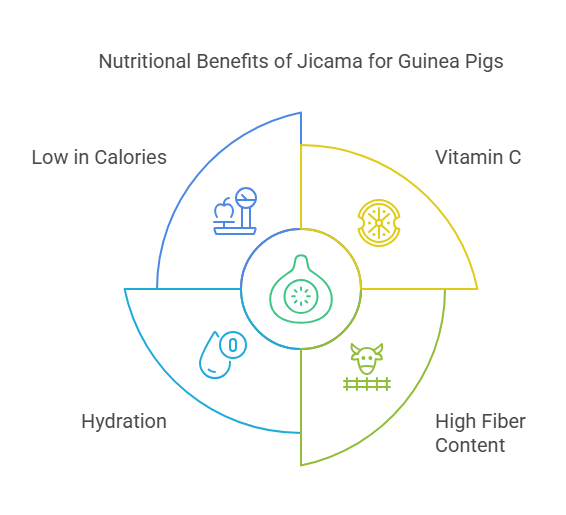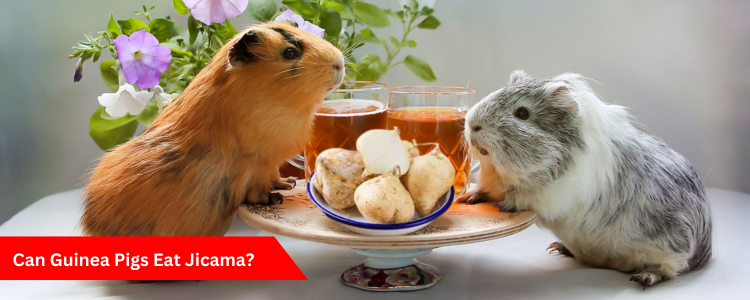Yes. Guinea pigs can eat jicama, but always ensure it’s peeled and given in moderation. Guinea pigs, also known as cavies, are curious and social animals that enjoy nibbling on various vegetables. As a guinea pig owner, you may be wondering whether jicama—an interesting root vegetable—can be safely added to their diet. Can guinea pigs eat jicama? Is it healthy for them, or could it cause harm? Let’s dive deep into the world of guinea pig nutrition and explore whether jicama is a safe treat for your furry friend.
Dr. Lisa Johnson, a small animal veterinarian, shares,
“Jicama is safe for guinea pigs as long as it’s prepared correctly. The most important thing to remember is to peel it thoroughly before feeding it to your pet. Offering jicama in moderation can provide a healthy, crunchy snack that benefits their digestion and provides vitamin C.”
What Is Jicama?
Jicama, often referred to as Mexican yam bean or Mexican turnip, is a popular root vegetable in Mexican and South American cuisine. Its pale, round shape and brown, papery skin are characteristic of the vegetable. Inside, jicama has a white, crunchy flesh with a slightly sweet, mild flavor, making it a refreshing addition to salads or eaten raw as a snack.
Jicama has a high water content, making it hydrating, while also being low in calories. It’s an excellent source of dietary fiber, vitamin C, and potassium, making it an appealing option for both humans and animals. However, just because it’s good for humans doesn’t automatically mean it’s safe for guinea pigs. Let’s examine how jicama stacks up against the dietary needs of guinea pigs.
Nutritional Value of Jicama

Before determining whether guinea pigs can eat jicama, it’s essential to understand the nutritional profile of this vegetable.
According to the USDA, a 1-cup serving (about 130 grams) of raw jicama contains:
- Calories: 49 kcal
- Carbohydrates: 11.5 grams
- Fiber: 6 grams
- Sugars: 4.6 grams
- Vitamin C: 22.5 milligrams (approximately 25% of the daily recommended value for adults)
- Potassium: 180 milligrams
- Calcium: 15 milligrams
Jicama is mostly made up of water and carbohydrates, making it a low-calorie and hydrating snack. It is particularly rich in fiber and vitamin C, two key nutrients for guinea pigs. Guinea pigs cannot produce vitamin C on their own, so it must be sourced from their diet. Without adequate vitamin C, guinea pigs can suffer from scurvy, a disease caused by vitamin C deficiency.
However, the high water content in jicama may pose concerns for some guinea pigs, particularly those with sensitive digestive systems. Let’s now explore whether these nutrients make jicama a safe food for guinea pigs.
Can Guinea Pigs Eat Jicama? The Answer
Yes, guinea pigs can eat jicama, but with some precautions. When offered in moderation, jicama can be a healthy addition to your guinea pig’s diet. However, as with any new food, it’s important to monitor your guinea pig for any adverse reactions.
Benefits of Jicama for Guinea Pigs
There are several potential benefits of including jicama in your guinea pig’s diet:
1. Vitamin C
Jicama is an excellent source of vitamin C, which is vital for guinea pigs. Unlike humans, guinea pigs cannot produce their own vitamin C, so they rely on their diet to get enough of it. Vitamin C helps to support their immune system, promote healthy skin, and prevent scurvy. Since jicama contains a notable amount of vitamin C, it can supplement other vitamin C-rich vegetables like bell peppers, kale, and parsley.
2. High Fiber Content
Guinea pigs need a diet rich in fiber to promote healthy digestion and prevent issues like constipation and bloating. Jicama contains a good amount of fiber, which can support healthy gut function. Fiber also helps with their dental health, as guinea pigs’ teeth constantly grow and need to be worn down by chewing fibrous foods like hay and vegetables.
3. Hydration
Due to its high water content (about 86%), jicama can help keep your guinea pig hydrated, especially during hot weather. Proper hydration is essential for guinea pigs to maintain healthy organ function and prevent urinary tract problems.
4. Low in Calories
Since jicama is low in calories, it can be a great snack for guinea pigs who are prone to obesity. Unlike high-calorie fruits like bananas or grapes, jicama won’t contribute to excessive weight gain when fed in small portions.

Potential Risks of Feeding Jicama to Guinea Pigs
While jicama has several benefits, there are also some risks associated with feeding it to guinea pigs. It’s important to be aware of these potential issues before offering jicama to your pet.
1. Toxins in the Skin
The skin of jicama contains a toxin called sapogenin, which can be harmful if ingested. While the inner flesh of jicama is safe for guinea pigs to eat, the skin should always be discarded. Never feed the skin to your guinea pig, as it can lead to digestive issues and other health problems. Be sure to peel the jicama thoroughly before offering it to your pet.
2. Digestive Upset
Jicama is high in fiber, which is beneficial for guinea pigs, but introducing too much fiber too quickly can upset their digestive system. Guinea pigs have delicate stomachs, and overfeeding them fiber-rich foods can lead to bloating, diarrhea, or stomach cramps. To avoid these issues, introduce jicama gradually and in small portions.
3. Choking Hazard
The crunchy texture of jicama might pose a choking risk if it’s not cut into small, manageable pieces. Always cut the jicama into thin slices or small cubes to make it easier for your guinea pig to chew and swallow. Avoid serving large chunks of jicama, as they could cause choking.
4. Potential for Overfeeding
While jicama is healthy, it’s important to remember that it should be just one part of a balanced diet. Guinea pigs require a variety of vegetables, hay, and a small amount of fruit. Jicama should not replace other essential foods, and overfeeding any vegetable can lead to nutritional imbalances.
How to Feed Jicama to Your Guinea Pig
If you decide to give jicama to your guinea pig, it’s essential to prepare it properly and offer it in moderation. Here’s how to safely introduce jicama into your guinea pig’s diet:
- Peel the Jicama: Never feed the skin, as it contains harmful toxins. Peel the jicama completely to expose the inner flesh.
- Cut into Small Pieces: Slice the jicama into small, bite-sized pieces to avoid choking hazards.
- Serve in Moderation: Start with a small amount (one or two small slices) and observe your guinea pig’s reaction. If they seem to enjoy it without any digestive issues, you can continue offering jicama occasionally.
- Monitor for Reactions: Keep an eye on your guinea pig’s behavior and stools after introducing jicama. If they experience bloating or diarrhea, discontinue feeding it and consult your veterinarian if necessary.
What Other Vegetables Can Guinea Pigs Eat?
While jicama is a good option in moderation, it should not be the only vegetable in your guinea pig’s diet. Here are other safe vegetables that guinea pigs can enjoy:
- Bell Peppers: High in vitamin C and low in calcium.
- Cucumbers: Hydrating and gentle on the digestive system.
- Leafy Greens: Such as romaine lettuce, kale (in moderation), and parsley.
- Carrots: Rich in vitamin A, but should be fed sparingly due to their sugar content.
- Zucchini: Another hydrating, low-calorie vegetable.
- Broccoli: Provides essential vitamins and minerals, but should be offered in moderation to avoid gas.
These vegetables, along with hay, should make up the majority of your guinea pig’s diet. Hay is essential for their digestive health, and fresh vegetables should be offered daily to ensure they get a variety of nutrients.

FAQs About Guinea Pigs and Jicama
1. Can guinea pigs eat jicama every day? No, guinea pigs should not eat jicama every day. It should be offered as an occasional treat in moderation. Variety in their diet is essential for optimal health.
2. Can jicama replace hay in a guinea pig’s diet? No, jicama should not replace hay. Hay provides the necessary fiber for guinea pigs’ digestive and dental health, while jicama can be a supplementary snack.
3. How much jicama can guinea pigs eat? Offer your guinea pig no more than one or two small slices of jicama per serving. Always monitor their reaction and adjust the amount if needed.
4. Is jicama toxic to guinea pigs? The flesh of jicama is not toxic, but the skin contains a toxin that can harm guinea pigs. Always peel the jicama before feeding it to your pet.
5. What other foods should guinea pigs avoid? Guinea pigs should avoid foods high in sugar (like fruits) and foods that are high in calcium (such as spinach and kale). Avoid iceberg lettuce, as it has little nutritional value.
In conclusion, guinea pigs can eat jicama, but it should be offered in moderation and with proper preparation. Jicama’s high fiber content and vitamin C make it a valuable addition to their diet, but overfeeding or feeding it improperly can lead to digestive issues. Always peel the jicama and cut it into small pieces before serving it to your guinea pig. By following these guidelines and offering a varied diet, you can ensure that your guinea pig stays healthy and happy.

